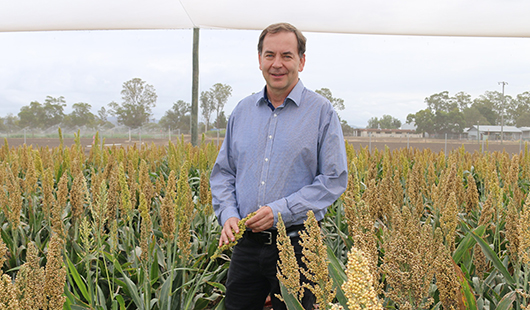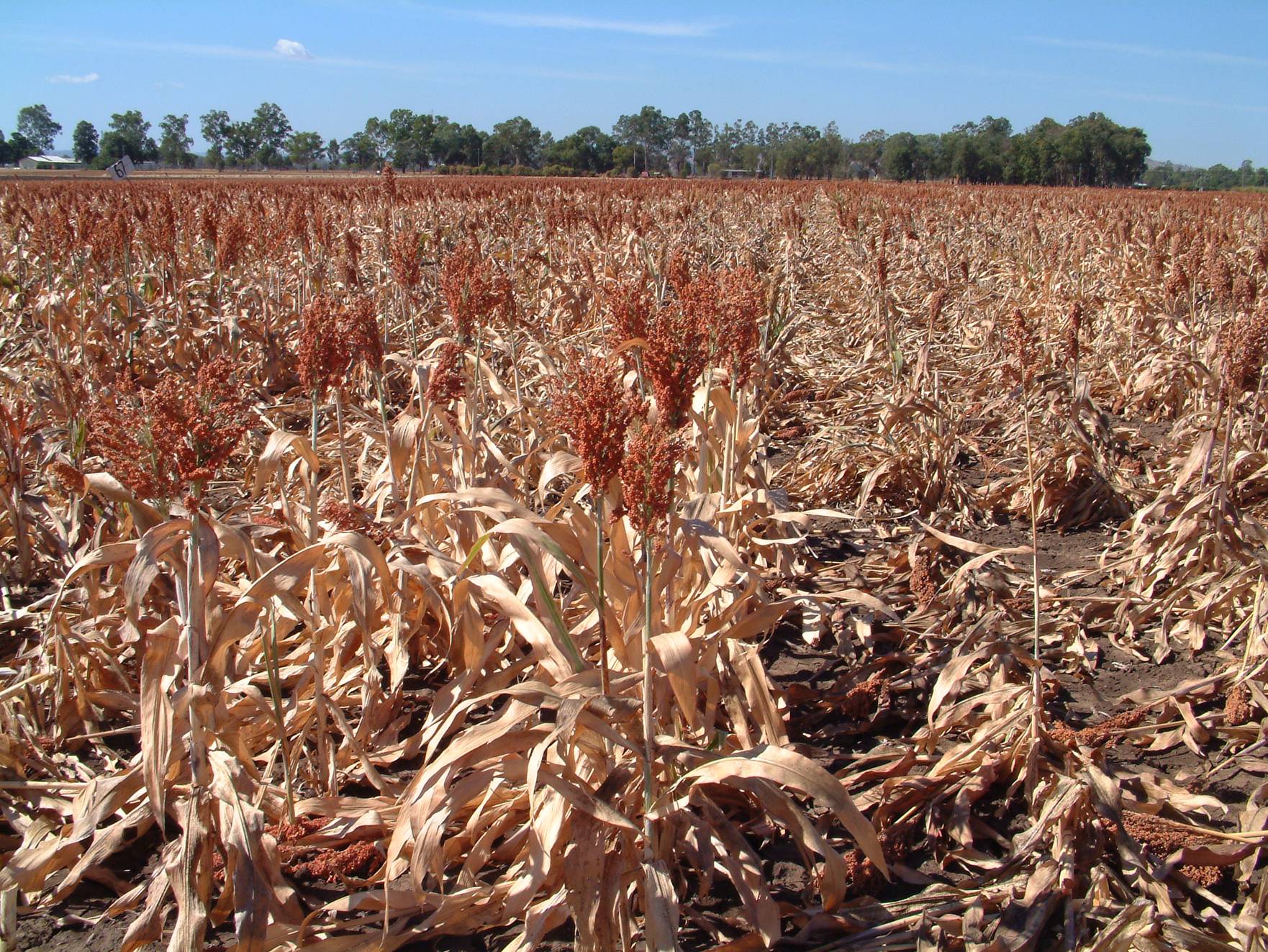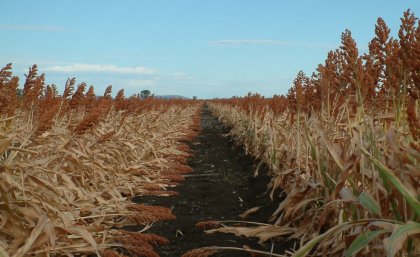After decades of collaborative study, University of Queensland sorghum researchers have identified a genetic solution to the problem of sorghum lodging which affects 10 per cent of sorghum crops every year.
Lodging refers to how the plant stands upright, when carrying high grain yields.
“Lodging is an issue that affects about 10 per cent of Australia’s sorghum crops a year, which are valued at $445 million,” Professor David Jordan said, a Professorial Research Fellow in the Queensland Alliance for Agriculture and Food Innovation (QAAFI).

Adverse events, such as a dry finish to an otherwise high-yielding season, can lead to 100 per cent crop losses.
“Losing a bumper grain crop because plants fall over is heartbreaking for growers and undermines efforts to increase production to improve food security,” Professor David Jordan said.
Sorghum is particularly prone to falling over or ‘lodging’, but Professor Jordan said scientific breakthroughs point to a genetic solution.
Professor David Jordan, together with a team from the Department of Agriculture and Fisheries (DAF) at the Hermitage Research Facility in in Warwick, found that lodging occurs whenever water scarcity forces a halt to photosynthesis.
“This forces the plants to rely on carbohydrates stored in the stems,” Professor Jordan said.
“The metabolic shift ultimately weakens the stems, culminating in their death. Pathogens can invade and further weaken stems, causing them to the break.”
Environmental conditions that give rise to stem damage and lodging were found to occur in most production regions, but with varying frequency and severity depending on the degree of water stress.
Doctoral student Xuemin Wang analysed data from 14 growing seasons and found that lodging frequency varies from 0 to 100 per cent, with the most severe lodging (greater than 20 per cent) observed in 2005, 2016 and 2017. The Southern Oscillation Index was shown to explain 29 per cent of the seasonal variation in lodging frequency.
“The study clearly supports a link between lodging incidence and water stress across regions and seasons,” Professor Jordan says.
“Our data also found that, despite substantial breeding efforts and turnover of commercial cultivars during the study period, the level of resistance to lodging appears not to have improved.”

Genetic mapping
The reason for stagnating genetic gain against lodging was also analysed by the QAAFI team.
The researchers found that traits used to drive up yields also introduced a susceptibility to lodging. An example of such a trait is plant height, which is essential to achieving higher yields but also raises the risk of lodging-inducing stem failure.
“The higher the yield potential of a sorghum hybrid, the more likely it is to suffer from lodging, creating a challenge for breeders trying to improve both traits,” Professor Jordan said.
To meet this challenge, scientists sought a full understanding of the genetics that underlie lodging.
The aim was to discern whether genes existed that associate with lodging resistance via mechanisms that would not adversely impact yields.
This proved a successful strategy.
“We undertook one of the largest genome-wide association studies done in sorghum in the world,” Professor Jordan said.
“This study looked at 2308 unique hybrids grown in 17 Australian sorghum trials over three years.”
Genetic mapping revealed that lodging is a complex trait in sorghum, with about 213 regions of the genome involved. That means variation in many genes are able to cause variation in lodging characteristics.
“A genome-wide view of the genetics is especially important going forward,” Professor Jordan said.
“It means we can discriminate among all the network of lodging-associated genes for those pathways that we can target for improvement without sacrificing yield potential.”
Targeted breeding at the cellular level

High on the list of viable candidates is the option to increase stem strength by altering the composition of the molecules used by the plant to assemble the supportive cell wall.
Bolstering disease resistance at the same time would offer additional protection to the stems.
Particularly attractive to researchers are genes involved in the biosynthesis of lignin, which is a woody molecule that adds a lot of strength to plant cell walls.
The research team is now poised to translate these kinds of insights into targeted breeding strategies that stand to directly benefit the Australian sorghum industry.
One approach under consideration involves screening genetically diverse sorghum collections for variation in the lignin biosynthesis genes.
Screening could be accelerated through the use of hyperspectral cameras that use near-infra-red light to measure the lignin content of stems without destroying the plant.
Ultimately, the team wants a strategy that rapidly delivers optimum benefits in growers’ paddocks. They know what it takes to deliver beneficial new traits into commercially viable cultivars.
Previously, Queensland sorghum researchers introduced greater drought resistance into Australian cultivars through the transfer of stay-green genes from sorghum sourced from Ethiopia.
Those same stay-green genes are now recognised to have introduced a level of resistance to lodging by delaying photosynthesis shutdown and stem death in response to water scarcity. It is these genetics that retrospectively allowed gains in yield potential in recent years without commensurate increases in lodging.
“We are at the point where we have come as far as we can with the stay-green mechanism for reducing the incidence of lodging,” Professor Jordan says.
“By generating the new genetic map, we can now identify new leads for breeding greater lodging resistance into high-yielding sorghum hybrids.”
The sorghum core pre-breeding project was funded by the Department of Agriculture and Fisheries (DAF) Queensland, Grains Research and Development Corporation (GRDC) and The University of Queensland (UQ). Field trial support for the project was also given by the sorghum pre-breeding team at Hermitage Research Facility based near Warwick in Queensland.
Xuemin Wang is financially supported by an Australian Government Research Training Program Scholarship and a Centennial Scholarship from The University of Queensland (UQ).
Investing in sorghum research:
- Grain sorghum is a major summer crop, produced at the moment largely as a feedgrain for the Australian domestic market.
- New markets for Australian sorghum are opening up in China for use in fermentation of alcoholic spirit, and in the gluten-free human food market.
- Genetics is one of the principal factors contributing to the current upward trend evident in Australian grain sorghum yields.
- The Queensland Government, along with the Grains Research and Development Corporation, and UQ, supported improvement and innovation in a sorghum pre-breeding program run out of Hermitage Research Facility for 20 years.
- The cost-benefits of this research mainly stem from yield gains, estimated at 2.1 per cent a year. This estimate is based on Australian Bureau of Agricultural and Resource Economics and Sciences (ABARES) data that shows average sorghum yields increased from about 2 to 3.5 tonnes per hectare between 1996 and 2015.
- The pre-breeding program has licensed nearly 3000 sorghum lines to the international sorghum industry since 1989, which is around 10 times the amount of plant breeding material than in all the other public sorghum breeding programs around the world – combined.
- The economic analysis of this investment over this period equates to a cost-benefit of $8.90 for every $1 invested by the research funders.
The research was published in Theoretical and Applied Genetics.
Media: Professor David Jordan, david.jordan@uq.edu.au, +61 7 4542 6722; Carolyn Martin, QAAFI Communications, carolyn.martin@uq.edu.au, +61 (0) 439 399 886. View UQ News media release 31 March 2021 here. Further images are available in DROPBOX.
The Queensland Alliance for Agriculture and Food Innovation is a research institute at The University of Queensland, established with and supported by the Queensland Department of Primary Industries.



